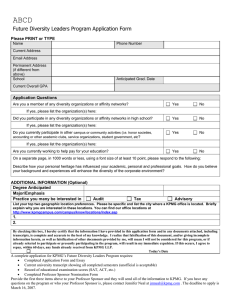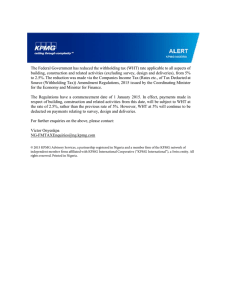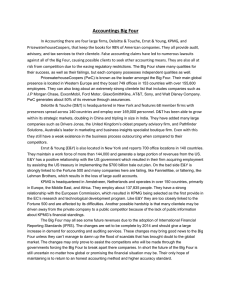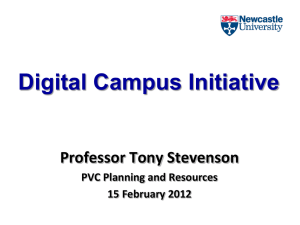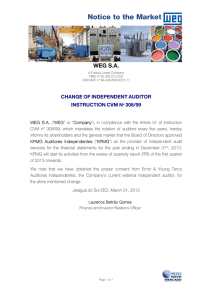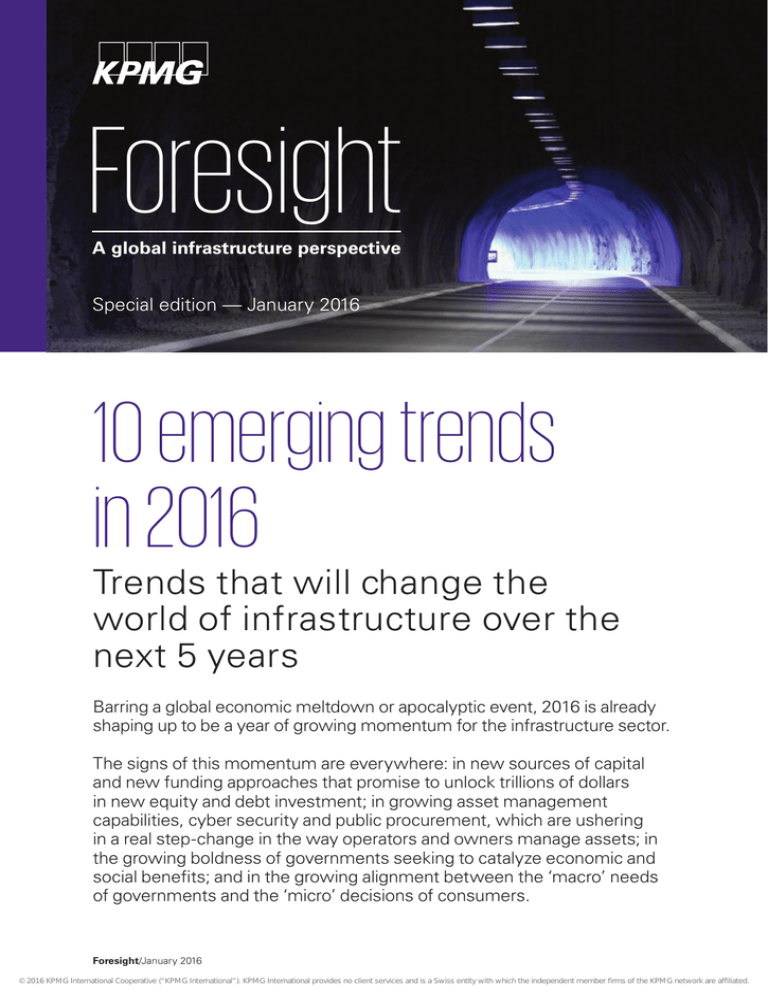
Foresight
A global infrastructure perspective
Special edition — January 2016
10 emerging trends
in 2016
Trends that will change the
world of infrastructure over the
next 5 years
Barring a global economic meltdown or apocalyptic event, 2016 is already
shaping up to be a year of growing momentum for the infrastructure sector.
The signs of this momentum are everywhere: in new sources of capital
and new funding approaches that promise to unlock trillions of dollars
in new equity and debt investment; in growing asset management
capabilities, cyber security and public procurement, which are ushering
in a real step-change in the way operators and owners manage assets; in
the growing boldness of governments seeking to catalyze economic and
social benefits; and in the growing alignment between the ‘macro’ needs
of governments and the ‘micro’ decisions of consumers.
Foresight/January 2016
© 2016 KPMG International Cooperative (“KPMG International”). KPMG International provides no client services and is a Swiss entity with which the independent member firms of the KPMG network are affiliated.
Over the past 4 years, KPMG International has tracked the
key trends that — in our opinion — will influence the world
of infrastructure over the coming years. Some of the trends
that we have identified in the past persist — governments
continue to struggle to unclog their pipelines; emerging
markets continue to face funding gaps; the optimal
relationship between the public sector, the private sector
and taxpayers continues to evolve. This is to be expected;
massive changes to fundamental problems do not happen
overnight.
As this year’s Emerging Trends in 2016 suggests,
however, the industry is now standing on the cusp of
James Stewart
Chairman of Global
Infrastructure
Stephen Beatty
Americas and India Head
of Global Infrastructure
greater change. The development and interaction of
many of these trends could very well transform the way
governments, businesses and users interact with and
invest in infrastructure. More importantly, if managed
properly, they also hold the power to solve many of the
biggest challenges facing our industry today.
Once again, we hope that this year’s insights serve to not
only highlight major trends but also to help readers see
some of the less obvious long-term changes affecting the
infrastructure sector. To discuss these trends and their
impacts in more detail, we encourage you to contact your
local KPMG infrastructure team.
Julian Vella
Asia Pacific Head of
Global Infrastructure
Foresight/January 2016
© 2016 KPMG International Cooperative (“KPMG International”). KPMG International provides no client services and is a Swiss entity with which the independent member firms of the KPMG network are affiliated.
Trend 1
Macro risk environment shifts: ‘No normal’ is the new normal
Last year, we noted that political and regulatory uncertainty
was creating challenges for infrastructure investors. But today,
political and regulatory risks are just the tip of the iceberg.
Uncertainty is everywhere: in unexpected election results and
political upheaval; in rising protectionist sentiments; in disruptive
and fast-moving technological advances; and in geopolitical and
social upheaval. Simply put, the stable conventional wisdom that
once underpinned infrastructure planning and investment seem
to no longer apply.
Interestingly, it’s largely the emerging and developing markets
that are using this uncertainty to make big plays. China’s ‘One
Belt, One Road’ project and the Asian Infrastructure Investment
Bank (AIIB) initiative will not only improve prospects for
economic growth in the region, they may also enable China to
assert greater regional power. Japan’s significant investments
into India’s manufacturing and infrastructure sectors;
Singapore’s championing of the ASEAN community; and the
Gulf States’ continued investment into western assets all carry
Trend 2
suggestions of power politics at work and more change
on the horizon.
While no investor likes uncertainty, it seems that many are
currently underpricing the increased risk into their models. In
part, this is likely due to the current ‘oversupply’ of equity in the
market which has forced investors to compete more fiercely for
investments. But, in time, we expect investors to start becoming
much more considered about the way they assess, manage and
price this type of uncertainty.
The long view:
The reality is that ‘no normal’ will probably be the ‘new
normal’ for the foreseeable future and investors will
need to get comfortable with uncertainty and learn
how to properly price these new and emerging risks.
Geopolitical power plays could create fundamental shifts
in the world order, trade and investment flows.
Competition for investments heats up
With more and more equity entering the market, competition for
‘investable’ infrastructure projects has reached fever-pitch.
In part, increased flows are being driven by institutional investors
eager to put their capital to work. But it is also being impacted
by increased investment activity by multinational and sovereign
sources (such as the African Development Bank Group (ADBG)’s
Africa50 Investment Bank for Infrastructure) which often
prioritize objectives other than pure return on investment (ROI)
and therefore tend to distort capital market flows and returns.
The problem is that increased equity flows are driving
competition which, in turn, is pushing down the yields that
investors can achieve on well-understood and low-risk
infrastructure investments. Multiples have soared for regulated
assets in mature markets; concerns are rising that some
may have already paid too much just to capture a share of
the market.
governments and owners still need to understand that private
capital will only be attracted (and sensibly priced) to markets that
create a predictable and stable investment environment.
The long view:
Over the long term, this shift will permanently alter the
dynamics of who takes what risks, when they take the risks
and how. Ultimately, however, we believe that this may
well be the tipping point that ushers in 50 years (or more) of
prosperity as capital starts to match up with projects which,
in turn, will drive economic growth in the developing world
and shore up retirement savings in the mature markets.
In response, a growing number of the more sophisticated
and active institutional investors are starting to leverage their
deep experience assessing and pricing risk, and implementing
operational improvement strategies to take on a wider range of
projects that offer the potential to deliver higher yields.
Some are investing into greenfield projects that naturally carry
higher levels of development risk. Others are taking a broader
view of infrastructure and investing in social and health assets.
And some (particularly the more sophisticated Asian funds) are
scouring the ‘frontier markets’ — emerging markets such as
Myanmar and Mongolia — to identify potential investments.
Clearly, this is good news for project owners around the world.
Indeed, as more equity enters the market and investors gain
experience at managing risk in their investments, we expect to
see access to equity start to increase and rates start to decrease
in both the developed and the developing world.However,
Foresight/January 2016
© 2016 KPMG International Cooperative (“KPMG International”). KPMG International provides no client services and is a Swiss entity with which the independent member firms of the KPMG network are affiliated.
Trend 3
Focusing on the larger benefits to unclog the pipeline
Two years ago, we predicted that governments would
move to unclog the pipeline. Last year, we noted a trend
towards greater government intervention in infrastructure
markets. Yet, with the impact of these actions proving
largely ineffectual, we expect (and hope for) 2016 to see
governments move a step further by focusing on getting
projects out the door rather than trying to perfect the
risk balance.
The reality is that many governments are starting to recognize
that — by striving to take a minimalist approach to risk or
to achieve structural and contractual ‘perfection’ — they
have in fact been missing the point and, in doing so, have
been making projects more complicated, less attractive to
investors and slower to take to market. Simply put, they have
been putting too much focus on being clever rather than
reaping the larger rewards (such as economic and social
prosperity).
We believe that 2016 will see governments start to take
stronger action to unclog the pipelines by taking the steps
required to get the private markets going. Government
leaders will recognize that — in many cases — establishing
markets and getting projects delivered (and realizing
the long-term economic and social benefits thereof) is
more important than minimizing risk or perfecting other
variables.
Trend 4
Somewhat tellingly, it has been the developed economies
that have most often tended towards interventionist activities
and these markets are driving procurement innovation. But
over the coming year, we expect to see many developing
markets start to follow in their footsteps to catalyze
investment. Indeed, should this trend unfold as hoped, we
could start to see a repeat of the activity catalyzed 25 years
ago in certain Latin American markets which, for example, led
to Chile’s highly-successful toll road concession program in
the late 1990s and early 2000s.
The long view:
Essentially, governments are starting to recognize that
it is the public sector that needs to energize projects
and that, to date, they have relied far too much on
the private sector to achieve their economic, social
and environmental objectives. The reality is that
the private sector is looking for commercial returns,
whereas government is seeking to achieve long-term
economic benefits and other national objectives.
As such, we expect to see governments start to
become more active in influencing and catalyzing their
infrastructure markets.
Asset management gets sophisticated
As infrastructure owners shift their focus from buying
new assets to maximizing the performance of the assets
they already own, the need for more sophisticated asset
management has risen up the agenda. Over the coming year
(and more), we expect to see both public and private sector
owners and operators become more sophisticated stewards
of their assets.
In part, this is because owners are keen not only to achieve
the full expected lifespans of their assets, but also to get more
productivity out of their existing operations. The achievement
of peak operational efficiency, the better management of
demand and capacity, the reduction of maintenance costs and
the delivery of improved customer service can enable owners
to gain access to the full potential of their investments.
Advances in technology, including the use of data/analytics,
are also adding to the sophistication of asset management.
No longer must decisions be made on ‘rules of thumb’;
today’s available technology allows asset managers to
carefully monitor their assets in real time and, in doing so,
improve decision making, manage capacity and maximize
efficiency. And, in the longer term, the increased use of
predictive data/analytics will shift the focus from reactive to
proactive maintenance.
In 2016, we believe that asset management will become
a key discipline for asset owners, enabled by smart
technologies, more sophisticated approaches and greater
insight into the actual operations and performance of
their assets.
The long view:
Given the pace of advancement in areas such as
Internet of Things (IoT), robotics and data/analytics, it
seems clear that technological advances will continue
to drive efficiency in infrastructure operations and
should lead to better productivity, longer asset lives,
fewer catastrophic failures and improved safety. In
this environment, owners will need an ever-more
sophisticated approach that combines technology,
data/analytics and asset management. They will also
need to consider the impact that this shift will have on
their existing labor force: operating infrastructure in
the new world will almost certainly require less hands
and fewer eyeballs.
Foresight/January 2016
© 2016 KPMG International Cooperative (“KPMG International”). KPMG International provides no client services and is a Swiss entity with which the independent member firms of the KPMG network are affiliated.
Trend 5
Technology rockets up the infrastructure agenda
Infrastructure has remained largely untouched by the
technology revolution underway around the world. With
the exception of the telecoms sector, there has been no
fundamental change in the type of infrastructure that is
built compared to 50 years ago. We still use the same
assets we did 50 years ago. And we still follow the same
basic assumptions we did 50 years ago.
But the reality is that the technology revolution is now upon
us. And it is rapidly and fundamentally disrupting the way we
plan, design, develop and operate our infrastructure.
Solar power technologies, for example, are not only
redefining the way power is generated, they are also
disrupting the ‘centralized’ generation and distribution
models that underpin most of the developed world’s energy
investment strategies. The technology for driverless cars is
developed; now the question is how they will be adopted
and integrated into society. And the continued efforts
to develop the Hyperloop threaten to shatter traditional
transportation assumptions.
Interestingly, much of the demand for technological
advancement is being driven by the consumers. In the
developing markets, concerns about the affordability of
conventional technologies are driving adoption of newer
approaches. In the mature markets, consumer desire for
more control over their infrastructure use is driving demand
for more sophisticated services.
Demand for technology is also being catalyzed by a growing
alignment between ‘macro’ infrastructure requirements (such
as reducing emissions) and the ‘micro’ consumer decisions
(such as investing in web-based home thermostats). Over
the coming year, we expect to see the macro and micro come
even closer into alignment as technology costs continue to
fall and consumer demand rises.
Over the coming year, we expect
to see the macro and micro come
even closer into alignment as
technology costs continue to fall
and consumer demand rises.
The long view:
While it is clear that consumers will continue to drive
decision making and progress, this isn’t about buying
into the newest technologies and consumer demands.
This is about understanding the direction, pace and
impact of technological change to make informed longterm decisions around investment, business models
and customer service.
Indeed, while much of today’s classic micro-economic
theory assumes that technology is ‘fixed’, this is clearly
no longer the case. Put simply, the infrastructure we
are going to need and use in 20 years’ time is going
to be very different from what we are using — and
designing — today.
Over the coming years, infrastructure owners and
operators will become much more comfortable with
technology and technological change. In fact, some
jurisdictions (such as those with high solar generation
potential) will leverage new technologies to essentially
‘leapfrog’ more evolved economies in terms of cost and
service availability.
Foresight/January 2016
© 2016 KPMG International Cooperative (“KPMG International”). KPMG International provides no client services and is a Swiss entity with which the independent member firms of the KPMG network are affiliated.
Trend 6
Security becomes a mainstream issue
Every government, regulator, owner and operator should be
worried about the security of their infrastructure. Given the
size and frequency of physical attacks, natural disasters and
cyber-attacks on critical infrastructure and in public spaces
over the past few years, it is clear that there is an urgent
need to reduce the vulnerability of infrastructure assets and
to protect citizens and users.
For some, this is about responding to a clear and present
danger. Terrorism is a very real threat to infrastructure (both
physically and through cyber-attack), particularly in densely
populated urban areas and during major events where any
action can have devastating and far-reaching consequences.
For many others, it is about taking the right steps and
making the right investments to protect the overall security
of their people, assets and economies.
The threat of cyber-attacks on infrastructure is increasing,
whether from terrorists or state-backed players bent
on disrupting perceived enemies; commercial hackers
looking for valuable data; or simply ne’er-do-wells and the
disenfranchised seeking a new thrill or challenge.
The challenge has been compounded by the growing
interconnectedness of systems. A hack on a state power
grid, for example, has the potential to disrupt millions of
businesses, individuals and other infrastructure systems
which, in turn, will disrupt millions of other businesses
and lives.
Part of the challenge is that few infrastructure executives
truly understand their risk profiles and controls; fewer still
fully understand the cyber element of the risk. And as
geopolitical tensions grow, the skills of cyber-attackers
become more sophisticated, and technology becomes more
interconnected, the threat will continue to shift and evolve.
One major challenge, however, is cost. Improving security
(particularly for existing assets) will require investment
across the lifecycle — from the design and planning phase
right through to operations and (in the case of nuclear
facilities, for example) decommissioning. But that will
require authorities to prioritize their security investments
and make difficult choices between security (which will
largely be invisible) and investment into expansion capacity.
In 2016, we expect public and private infrastructure owners
to place more emphasis and invest towards developing
guiding principles, clearly defined responsibilities and
major initiatives designed to enhance both physical and
cyber security.
The long view:
With political unrest on the rise in many parts of
the world and several high-profile, cross-border
infrastructure projects underway or currently being
planned, the physical and cyber security of assets will
only increase in importance, particularly to individuals
and users. Notwithstanding a ‘breakthrough’ in cyber
protection, expect security to start taking up a larger
portion of infrastructure budgets.
Foresight/January 2016
© 2016 KPMG International Cooperative (“KPMG International”). KPMG International provides no client services and is a Swiss entity with which the independent member firms of the KPMG network are affiliated.
Trend 7
The gap between public and private narrows
Ever since the rise of privatization and public-private partnership
(PPP) models in the 1980s, most governments have operated
under the assumption that the private sector outperforms
the public sector when it comes to procuring and delivering
infrastructure. But this can no longer be taken for granted.
The reality is that public sector capability and capacity
has — in many places — significantly improved. Recognizing
they are now being benchmarked against private sector
performance measures, many have learned valuable lessons
and have now incorporated private sector practices into their
own organizations. While public sector appetite for investing in
sufficiently skilled and appropriately compensated resources —
whether it be for project management or operations — remains
a significant concern, the gap between the public and the private
sector is starting to narrow.
The long view:
While the movement towards privatization and PPP
over the past few decades certainly answered some
long-standing concerns about public sector capabilities,
it has also proven to be a catalyst to public sector
improvement. Over the long term, we expect the private
and public sectors to continue to drive each other to
achieve ever-higher levels of performance, regardless
of the chosen implementation method. As a result, we
expect to see fewer public and private decisions being
made on ‘ideological’ rounds in the future.
That is not to say that the private sector’s role in infrastructure is
diminishing — quite the opposite. In fact, the last few years have
seen the rise of a phalanx of global developers and operators
in key segments such as ports, airports and transportation as
governments continue to leverage the specialized expertise of
the private sector to drive improved results.
Ultimately, we expect to see the knowledge gap between public
and private sectors continue to shrink as the cycle of interaction,
experience and improvement continues.
Trend 8
Innovative new ways to fund infrastructure emerging
As responsibility for investment into infrastructure starts to
devolve to state and city-level governments and central/federal
funding becomes increasingly constrained, many are starting to
look for new ways to unlock capital.
For the vast majority, the challenge is simply about finding
enough money to go around. But some are also looking for new
ways to ensure that the cost of infrastructure development is
borne by those that most directly benefits from it.
In 2016, we expect the trend towards user-pay, identified in
previous years, to continue and grow. We also expect to see
governments start to focus on bringing forward and capturing
both the current ‘stores’ of value and the future value that
they expect their projects to deliver in order to fund its
development.
For some, pragmatism will lead to more boldness in the
privatization of assets (or, to give it its politically correct
term, ‘asset monetization’). Rather than shrinking away from
the political implications of privatization, governments will
increasingly see privatization as a smart way to recycle capital in
order to fund new services and assets.
Yet, to achieve this, a clear and compelling logic for the use of the
proceeds of monetization — well articulated to the population —
is an absolute prerequisite. Australia is leading the way on this
but many other countries are beginning to follow, albeit on a
smaller scale.
At the same time, we expect to see new innovative ways of
‘value capture’ emerge and public authorities will get tougher
and smarter with private developers who own land surrounding
projects. Others will likely leverage the value that will be gained
by homeowners and businesses within proximity to the asset
through land taxes and development taxes. And we will almost
certainly see new taxes being developed and ring-fenced to fund
future infrastructure investment.
The challenge, however, will come in localizing the approach
to value capture. Much will depend on politics, local customs,
expectations and norms.
The long view:
For now, these new innovations in terms of raising
funds have been largely isolated to developed markets
and, as such, approaches for value capture have yet
to penetrate into the developing world. Over the
long term, we expect to see the more progressive
emerging markets quickly adopt these methods, both
at the local and at the central level, with the more
risk-averse markets following up in a ‘second wave’
of value capture. And this, in turn, should unlock new
sources of funding to bridge the developing world
infrastructure gap.
Foresight/January 2016
© 2016 KPMG International Cooperative (“KPMG International”). KPMG International provides no client services and is a Swiss entity with which the independent member firms of the KPMG network are affiliated.
Trend 9
The institutional debt market takes off
Over the past year, we have seen a significant uptick in the
volume and size of institutional debt deals. And all signs
indicate that 2016 will see institutional debt markets really
start to take off.
Much will depend on how the multilateral banks choose to
use their capital. Many have now recognized that their current
lending models are insufficient to drive the scale of change
required. Most now believe that their capital would be better
put to work by leveraging multiples of private sector capital
through financial instruments that enhance the credit of the
senior debt portion of the financing and, in doing so, give
access to the full extent of the capital markets.
The result should be a massive injection of institutional
debt over the coming years. The newly minted Asian
Infrastructure Investment Bank (AIIB), for example, has
clearly stated that it will use some of its US$100 billion to
catalyze private sector investment. The EU’s Juncker Plan
aims to turn EUR21 billion of public money into EUR315
billion of private investments. Others are now shifting their
models in the same direction.
Trend 10
That being said, changes in policy often take some time to
translate into action so there may be some delay before the
acceleration in investment takes hold. The risk in the short
term is that limited deal flows will see new public sector
capital crowd out private sector debt. This is acceptable for
a short period, but only if it acts as a catalyst for a new and
greatly expanded institutional debt market.
The long view:
The big question is whether the multilaterals will be
able to take the right steps at the right time to truly
unlock private investment. If they are able to get it
right, the world should enjoy the massive benefits
that will flow from a more-liquid debt market. But the
long-term prize must stay clearly in view; the goal here
is not to invest billions over the next 2 years but rather
to catalyze some US$70 trillion in investment over the
next 30 years.
China and India have arrived
Over the past year, it has becoming increasingly clear that
China and India are successfully making the leap from
‘emerging’ markets to ‘developed’ markets.
China is showing signs of opening its domestic market to
international investors and has published a pipeline of more
than 2,000 public-private partnership (PPP) projects. And
internationally, China is shifting from bilateral (government-togovernment) deals to instead start competing in open market
tenders. Chinese companies are becoming more acquisitive
as they seek to compete in international markets and Chinese
technology is gaining traction and meeting quality thresholds.
The Asian Infrastructure Investment Bank and the “One Belt,
One Road” project have the potential to be game changers.
India, following the election of Modi, is also becoming a force
to be reckoned with in the global infrastructure market. Yet
while India is the fastest growing large economy in the world,
it is also 142nd in terms of ‘ease of doing business’.1 Positive
change in this measure would be transformative, particularly
because, by 2025, a quarter of the world’s working age
population will be located in India and this workforce is well
educated, multilingual, highly skilled and lower cost. Already,
India is proving to drive innovation on a world-scale.
role of principal. In particular, we expect growing influence from
India in the provision of professional services, leveraging its low
cost base and access to skilled people.
The long view:
While this story is only just formulating, it seems clear
that the center of gravity in the global infrastructure
market is fundamentally shifting towards the East.
Today, companies from India and China successfully
compete on par with Western competitors and both
markets are generating new ideas, products and value
at an unprecedented pace. Over the long term, expect
more and increasingly sophisticated competition from
these markets.
Interestingly, China’s shift towards a developed economy is
largely being driven by the country’s corporate sector: China’s
companies (both state-owned and private) have rapidly adopted
the technologies and approaches of others to quickly build
their capabilities. In India, however, the shift is being driven by
entrepreneurs: no longer mere subcontractors to ‘western’
services firms, the country’s entrepreneurs increasingly play the
http://www.newindianexpress.com/nation/India-Ranks-142-in-Ease-of-DoingBusiness-Among-189-Economies-World-Bank/2015/09/15/article3028226.ece
1
Foresight/January 2016
© 2016 KPMG International Cooperative (“KPMG International”). KPMG International provides no client services and is a Swiss entity with which the independent member firms of the KPMG network are affiliated.
Will solar power
become the
world’s biggest
single source of
energy before
2025?
Will the completion
of the Panama
Canal transform
global trade?
Will the onsite
workforce of a
nuclear power
station consist of
just two people?
Will robots take over
infrastructure
operations?
What impact will
communications
technology have on the
demand for
office/commercial
space?
Will infrastructure
investment reduce
the 30 percent
world food wastage
challenge?
of
Questions for
Will more corruption
come to light?
Where?
2025
How will coastal regions
address the threat of
rising sea levels?
and beyond…
Will
How will aging
populations influence
infrastructure needs?
Will demand for
aviation travel
continue to
grow? Where?
How will
driverless cars
influence
road and rail safety
and security?
Will Hyperloop
technology render
current high
speed rail projects
redundant?
Will it work
at scale?
Will physical
commuting become
a thing of the past?
How will rising
population levels in
Africa influence
infrastructure
investment?
Is housing in the
developing world
about to take off as
an infrastructure
sector?
Foresight/January 2016
© 2016 KPMG International Cooperative (“KPMG International”). KPMG International provides no client services and is a Swiss entity with which the independent member firms of the KPMG network are affiliated.
Bookshelf
Insight
To access the publication listed,
visit: kpmg.com/infrastructure
or email us at:
infrastructure@kpmg.com
The Global Infrastructure Magazine
Issue No. 6 — Population
This edition of Insight takes a
closer look at the link between
unprecedented population changes
and demographic shifts currently
underway and the infrastructure
needed to meet these challenges.
It also includes a Special Report on
Asia Pacific’s infrastructure market.
Issue No. 7 — Who controls our
infrastructure?
In this edition of Insight, we sat down with
the world’s operators, owners, investors
and regulators to explore some of the
big challenges and trends influencing the
debate around infrastructure control.
It also includes a Special Report on Rail.
KPMG Global Infrastructure publications and reports
Infrastructure 100: World
Markets Report
In the third Infrastructure 100,
KPMG highlights key trends
driving infrastructure investment
around the world and a global
panel of independent industry
experts identify 100 of the world’s
most innovative, impactful
infrastructure projects.
KPMG Toll Benchmarking Study 2015:
An evolution in tolling
This study helps toll road owners, operators
and governments compare key metrics such
as cost to collect and operational efficiency.
Based on in-depth survey data collected from
more than 40 tolling agencies world-wide, it
provides organizations with an unprecedented
view into the challenges, risks, costs and
opportunities facing the tolling sector today.
Global Construction Survey series
2015 Global Construction Survey:
Climbing the curve
In the ninth edition, we focus on the
challenges facing owners as they
strive for a balance between power,
responsibility and control. This report
gauges the views of over 100 senior
executives of leading private and public
organizations from around the world.
Foresight
2013 Global Construction Survey:
Ready for the next big wave
The 2013 report catches the industry
in a more upbeat mood after gauging
the views of 165 senior executives of
leading engineering and construction
firms from around the world to
determine industry trends and
opportunities for growth.
A global infrastructure perspective
New mine expansion could kickstart the Mongolian economy
Mark Eberst discusses how
Rio Tinto’s Oyu Tolgoi mine
development could catapult
Mongolia into the global minerals
Premier League and give a muchneeded kick-start to its economy.
Argentina’s election result spells
optimism for infrastructure
investment
Mariano Sanchez and Martin Lopardo
think Argentina’s newly elected
President Mauricio Macri is sending
out a message to foreign infrastructure
players — his resource-rich country is
very much open for business.
Foresight/January 2016
© 2016 KPMG International Cooperative (“KPMG International”). KPMG International provides no client services and is a Swiss entity with which the independent member firms of the KPMG network are affiliated.
KPMG’s Global
Infrastructure
Practice
Integrated Services
Impartial Advice
Industry Experience
When it comes to infrastructure, KPMG member firms know what it takes to drive value. With extensive experience in most sectors
and countries around the world, our Global Infrastructure professionals can provide insight and actionable advisory, tax, audit,
accounting and compliance-related services to government organizations, infrastructure contractors, operators and investors.
We help clients to ask the right questions that reflect the challenges they are facing at any stage of the lifecycle of infrastructure
assets or programs — from planning, strategy and construction through to operations and hand-back. At each stage, KPMG’s Global
Infrastructure professionals focus on cutting through the complexity of program development to help member firm clients realize the
maximum value from their projects or programs.
Infrastructure will almost certainly be one of the most significant challenges facing the world over the coming decades. That is
why KPMG’s Global Infrastructure practice has built a team of highly-experienced professionals (many of whom have held senior
infrastructure roles in government and the private sector) who work closely with member firm clients to share industry best practices
and develop effective local strategies.
By combining valuable global insight with hands-on local experience, KPMG’s Global Infrastructure practice understands the
unique challenges facing different clients in different regions. And by bringing together numerous disciplines such as economics,
engineering, project finance, project management, strategic consulting and tax and accounting, KPMG’s Global Infrastructure
professionals work to consistently provide integrated advice and effective results to help member firms’ clients succeed.
For further information, please visit us online at kpmg.com/infrastructure or contact:
James Stewart
Global Infrastructure Chairman
Partner, KPMG in the UK
E: jamesa.stewart@kpmg.co.uk
Stephen Beatty
Americas and India Head of Global
Infrastructure
Partner, KPMG in Canada
E: sbeatty@kpmg.ca
Julian Vella
Asia Pacific Head of Global
Infrastructure
Partner, KPMG in China
E: julian.vella@kpmg.com
Foresight/January 2016
© 2016 KPMG International Cooperative (“KPMG International”). KPMG International provides no client services and is a Swiss entity with which the independent member firms of the KPMG network are affiliated.
Contact us
Dane Wolfe
Marketing Manager
Global Infrastructure
KPMG International
T: +1 416 777 3740
E: dmwolfe@kpmg.ca
kpmg.com
kpmg.com/socialmedia
Pranya Yamin
Marketing Manager
Global Infrastructure
KPMG International
T: +1 416 777 8094
E: pyamin@kpmg.ca
The information contained herein is of a general nature and is not intended to address the
circumstances of any particular individual or entity. Although we endeavor to provide accurate and
timely information, there can be no guarantee that such information is accurate as of the date it is
received or that it will continue to be accurate in the future. No one should act on such information
without appropriate professional advice after a thorough examination of the particular situation.
© 2016 KPMG International Cooperative (“KPMG International”), a Swiss entity. Member firms
of the KPMG network of independent firms are affiliated with KPMG International. KPMG
International provides no client services. No member firm has any authority to obligate or bind
KPMG International or any other member firm vis-à-vis third parties, nor does KPMG International
have any such authority to obligate or bind any member firm. All rights reserved.
The KPMG name and logo are registered trademarks or trademarks of KPMG International.
kpmg.com/app
Designed by Evalueserve.
Publication name: Foresight.
Publication number: 133113-G
Publication date: January 2016

